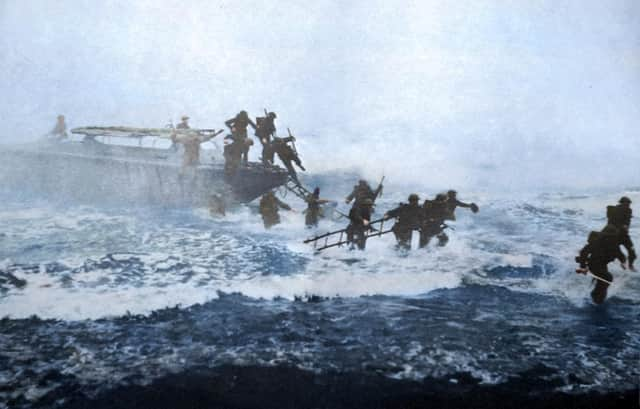D-Day: The Scottish castle where 250,000 soldiers prepared for Normandy landings


Set deep in Argyll and beyond the range of all German reconnaissance aircraft, Inveraray Castle became the nerve centre for preparations for D-Day.
Set up in October 1940 as part of Churchill’s programme to ‘hit back at the enemy’, the The No 1 Combined Training Centre (CTC) was created across Inveraray with the military requisition of large parts of Argyll Estates aided by the friendship between Winston Churchill and Niall Campbell, 10th Duke of Argyll, who were old school friends
Advertisement
Hide AdAdvertisement
Hide AdOn the shores of Loch Fyne, some 250,000 troops became versed in the movements that were to define D-Day - the use of smaller landing craft for beach assaults. This mode of proposed attack followed Churchill’s call in June 1940 for “specially trained troops of the hunter class who can develop a reign of terror down their coasts”.
As he sought a “ceaseless offensive” against the whole German occupied coastline, Inveraray – and at least 14 other CTCs in Scotland – delivered his aim with a training mission to “put the army ashore in the right place at the right time”.
As training commenced, Inveraray was transformed from sedate country town to a place that pulsed with army and naval activity. Churchill, it is remembered, was a regular visitor.
Kenny Whyte, the chief guide at Inveraray, said: “Inveraray C.T.C was a huge operation, catering for up to 15,000 instructors, maintenance staff and students in seven Nissen hutted sub-camps and two accommodation ships."
Today’s Argyll Caravan Park was the location of the H.M.S. Quebec naval base with the army located in Kilbride and Chamois camps nearby. Soldiers filled the castle grounds with tents dotted throughout the town. In the grounds of Fern Point, a Nissen hut was established as a decontamination centre and a cinema appeared in castle grounds for the servicemen, who appeared in Inveraray 15,000 at a time.
Several key properties in Inveraray were requisitioned including Dalchenna house and Tigh-Na- Craig, which became Admiralty House.
Two hotels in Largs were essential to the new programme with the Vanduara becoming Combined Operations HQ under the name of HMS Monck, with 27 telephone lines fitted. The Hollywood became HMS Warren where Operation Rattle was launched in June 1943. Chaired by Lord Mountbatten, Chief of Combined Operations, it was attended by the most senior officers from all services with the initial details of a landing in France established. The old Holywood hotel itself became a training centre for senior officers in amphibious warfare.
As preparations for D-Day took off, every assault formation was pushed through Inveraray on two-week courses with British, Canadian, Australian, New Zealand, American, Free French, Polish, Czech and Dutch troops summoned to the Argyll base during its lifetime.
Advertisement
Hide AdAdvertisement
Hide AdMr Whyte added the “intriguing possibility” that one group was composed of German nationals who had been given Welsh identities and formally adopted by families in Wales in order to have a cover story in case of capture.
Soldiers were given extensive training in beach assault and landing operations including the development of specialised landing craft and amphibious vehicles. According to one account, the town was often the scene of attack and defence manoeuvres from doorway to doorway and close to close.
"Khaki clad men armed with Tommy guns and revolvers would overrun the streets, whilst townspeople carried on with their normal activities,” one report said.
Major Hugh Gillies, company commander with the 1st Kings Own Scottish Borderers, attended Inveraray in January 1944.
He wrote: “ I threw myself into the uninviting Scottish swell and struggled ashore, followed by my company, during the next few day of exercise my clothes froze on me but such was my high state of physical fitness, that I did not catch so much as a cold.”
Another company commander, Major Francis Goode, who landed in Normandy on D Day with the Gloucester 56th Independent Brigade supporting 50th Division, took his men through an Inveraray course in March 1941. His account inferred that 10 infantrymen drowned on the loch following an accident.
“We practised getting in and out of the landing craft, which were manned by enthusiastic marines one of them, we were told, had been too enthusiastic and steering his assault craft across the loch in semi-darkness, hit a buoy, thinking it was the beach ordered down ramp, and some ten fully equipped infantrymen dashed into the loch and vanished forever,” he wrote.
Mr Whyte said entries from the Duke’s diary reflected an increase in intensity of exercises as June 6 1944 grew closer.
Advertisement
Hide AdAdvertisement
Hide AdOn January 28, the Duke “heard big guns down the Loch about 10 am like we did yesterday” with a thick fog screen hanging about for “some hours”.
“Machine gun as usual rattling beyond the quarry,” he wrote.
On March 10, 1944, a “huge convoy” came in after a dawn exercise on Ardno beach at Cairndow where two men were killed by defective mortars. Later that month, the loch was “full of activity” with “much heavy firing”.
Some traces of Inverary’s military past can be found through Argyll Estates and a museum of the The No 1 Combined Training Centre was run in the town for many years by Jim Jepson, a military veteran of Furnace, who is considered a great authority on the period. Inveraray Castle is now hosting an exhibition called ‘Somewhere in Scotland’ which was how the CTC was cryptically referred to in marching orders.
Comments
Want to join the conversation? Please or to comment on this article.
